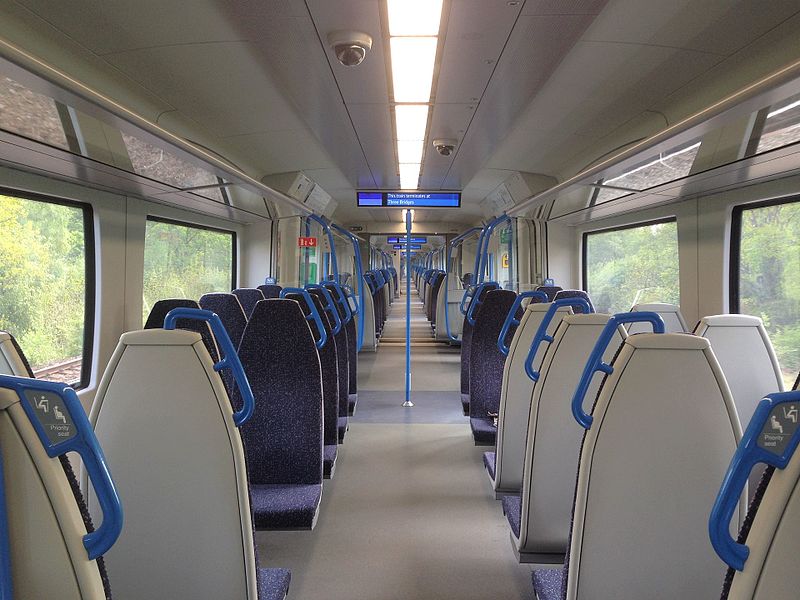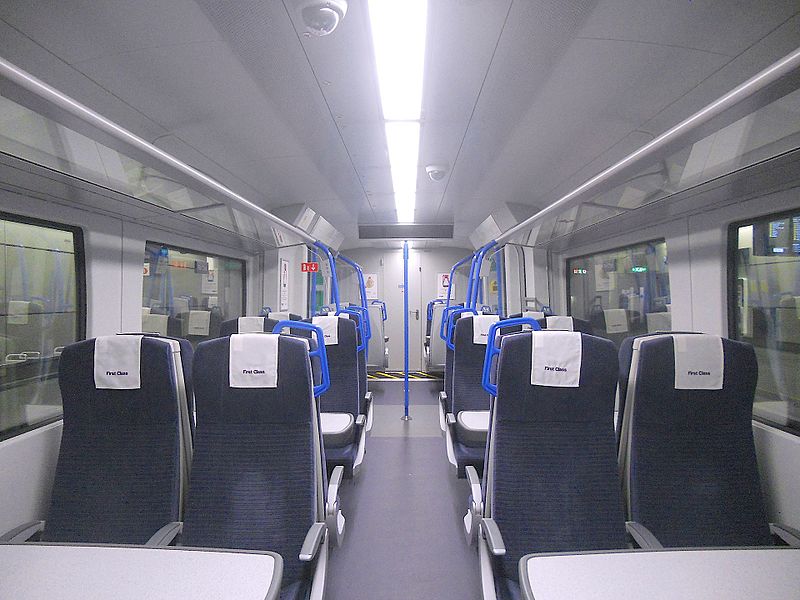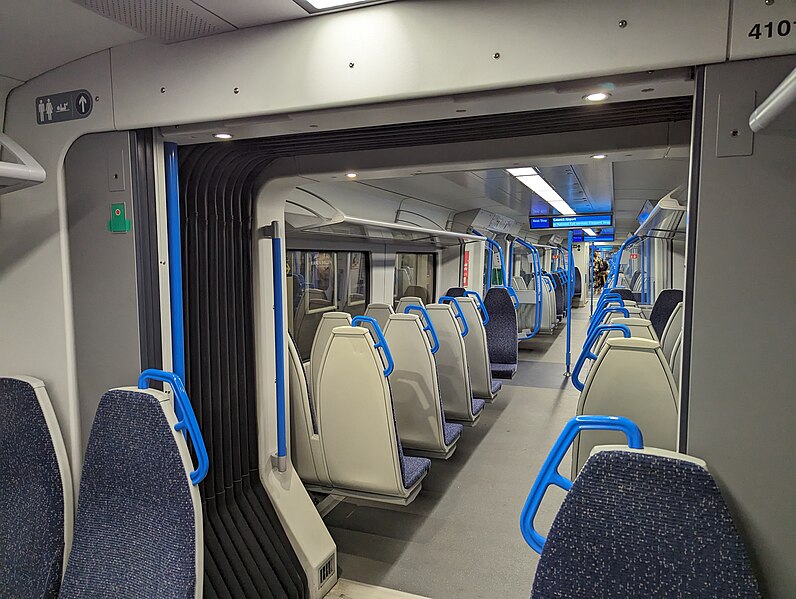Class 700
On this page
Specification table & more images at bottom of page
Est. reading time:
Page Settings
Font:
Font Weight:
Text Size:
Width:
Create an account for enhanced personalisation!
Search Wiki
The Class 700 is an electric multiple unit from the Desiro City family built by Siemens Mobility. It is capable of operating on 25 kV 50 Hz AC from overhead wires or 750 V DC from third rail. 115 units were built between 2014 and 2018, for use on the Thameslink network, as part of the Thameslink Programme in the United Kingdom. As of 2021, they are operated by Govia Thameslink Railway.

A Class 700 at Bedford in 2024
In 2011, the consortium Cross London Trains (XLT) consisting of Siemens Project Ventures, 3i Infrastructure, and Innisfree was announced as preferred bidder with Siemens Mobility to manufacture the trains. The decision was politically controversial as the trains were to be built in Germany, while the competing consortium led by Bombardier Transportation had a UK train factory. Both the procurement process and final close of contract were significantly delayed, resulting in the expected first delivery date moving from 2012 to 2016. The £1.6 billion contract to manufacture and provide service depots for the trains was finalised in June 2013. The first train was delivered in late July 2015.
A fleet of 60 eight-car and 55 twelve-car trains entered service between Spring 2016 and 2019. Having replaced the Class 319, Class 377, and Class 387, Class 700s are the only trains operated on the Thameslink network. Each train is able to reach 100 mph (160 km/h) and carry 1,146 passengers in an 8-car train, and 1,754 passengers in a 12-car train. Maintenance depots have been built at Hornsey and Three Bridges.
Background & History
The Department for Transport began its procurement process (Thameslink Rolling Stock Project, or Thameslink Rolling Stock Programme) on 9 April 2008, with the aim of introducing more passenger capacity on Thameslink lines to match expected demand. In addition, the bidders were to provide depots for vehicle maintenance and storage and finance for the rolling-stock project whereby revenues would be generated from the long-term leasing of rolling stock to the train operating company and associated maintenance payments.
The general specifications included: high reliability, short station dwell times, integrated information technology including passenger information and information for vehicle maintenance, a top speed of 100 mph (160 km/h), and high acceleration and deceleration performance in line with a high-frequency timetable. The trains were to be designed for low weight, low track forces, and high energy efficiency. A standard 12-car train was to be about 240 metres (790 ft) long and shorter 8-car trains were limited to 162 metres (531 ft).
Advertisement
The passenger accommodation was to include versions for both "metro" and "commuter" trains, based around a 2+2 seating arrangement, with fold-up seats and designed for high levels of standing passengers. Ride quality and noise levels were expected to equal or be better than those of current vehicles and climate control (air-conditioning) was to be fitted. The vehicles were to be fitted for driver-only operation, and to include GSM-R communications radio, as well as AWS, TPWS, and ERTMS level 2 safety systems. The ability to be used in 'Automatic train operation' (ATO) mode, where an on-board computer controls the motors and brakes, was also specified.
Vehicles were to operate on 750 V DC and 25 kV AC electrification systems, with regenerative brakes. Maintenance time was to be reduced by the use of modular components, remote diagnostics, and the avoidance of over-complicated systems. The Department for Transport gave a target of 384 tonnes (378 long tons; 423 short tons) when empty for a 243 m (797 ft) train.
Design & Manufacturing
Development of the new SF7000 bogie began in 2007, with the intention that it would be the UK-market replacement for the preceding Siemens SGP SF5000 model. To reduce energy consumption and track access charges, a key feature of the design was reduced weight: weight-saving design elements included short wheelbase, inboard frames, a bolsterless bogie design, and hollow axles. Total bogie weight is 6.3 tonnes (powered) and 4.4 tonnes (trailer), a reduction of around one third from the SF5000 design.
The primary suspension system uses layered rubber, with pneumatic secondary suspension. Motor bogies have a wheelbase of 2,200 mm (87 in), while trailer bogies are 100 mm (3.9 in) shorter. Both variants use wheels of 820 mm (32 in) nominal diameter. Braking is by tread brakes and regenerative braking on motor bogies, and two axle-mounted disc brakes per axle on trailer bogies.
Prototypes of the new bogie were completed at Siemens' bogie plant in Graz, Austria in late 2011. Manufacture of pre-series production trainsets began before formal financial close of the project in mid-2013.
A mock-up of the train was unveiled at the ExCel centre in January 2014, and then displayed at various stations in London and the surrounding area. In March 2014, testing of a twelve-car unit began at the Wegberg-Wildenrath Test and Validation Centre; a completed unit was presented by Siemens in Krefeld, Germany in April 2015.
Introduction into service
The first train arrived in the UK by the end of July 2015, and was delivered to the Three Bridges depot. The first test run on the Brighton Main Line took place in December 2015.
The first train in service was unit 700108 forming the 1002 Brighton to London Bridge service on 20 June 2016. By 18 September 2017, Class 700s replaced all Class 319, 377, and 387 units previously in use on the network. All units were accepted by Thameslink by summer 2018, and by the end of 2019 all were in passenger service.
Advertisement
The Class 700 fleet, at 60 eight-car and 55 twelve-car units, is over double the size of the old Thameslink fleet. This increase has been used not only to enhance capacity, but also to expand the Thameslink network.
On 6 November 2017, Class 700s started on the Great Northern route with the first, 700128, operating the 0656 Peterborough to London Kings Cross service. The Great Northern route has since been partially incorporated in the Thameslink network after through services through the Canal Tunnels began on 26 February 2018. On this route, Class 700s replaced parts of the Class 365 fleet.
On 11 December 2017, Class 700s took over peak-time services from London Bridge to Littlehampton and weekday-only services from London Bridge to Horsham from Southern with the former starting from Bedford instead of London Bridge.
From 21 May 2018, Class 700s also entered service on the new Rainham to Luton service, having replaced the Southeastern Class 465s from Gillingham to London Charing Cross. The Class 465s are now being used to enhance capacity on other routes.
Class 700s are still due to enter service on a planned new service between Cambridge and Maidstone East but a date for this has not yet been confirmed.
The Class 700 units have been criticised for having fewer seats than those they replaced. There are 666 seats on the twelve-car versions of the Class 700, compared to 714 on a twelve-car formation of a Thameslink Class 377/5 and 807 on a twelve-car formation of a Great Northern Class 365. The reduction in the number of seats is intended to provide more standing room on busy trains into Central London, but has been criticised by those who use the trains for longer journeys. There will, however, be more seats overall, as the services will run more frequently.
Additionally, the seats themselves have been criticised for being an uncomfortable shape and having insufficient padding. They are also narrow and positioned close together – another design intended to increase standing space. These poor levels of comfort, along with their tall, thin, tapered appearance, have led them to sometimes be nicknamed "ironing boards"; they have also been likened to sitting on concrete.
Advertisement
Thameslink have claimed that the lack of padding was required to meet fire regulations; however, the Rail Safety and Standards Board have claimed that this is untrue, and that it was simply a measure by the DfT to reduce costs.
Upon delivery, the trains were also missing various amenities which were considered standard, including seatback tables and Wi-Fi, which are now being retrofitted to some units. As of April 2023, 58% of Class 700/1 (12 coach) and 23% of Class 700/0 (8 coach) are fitted with Wi-Fi with no plans to extend this further across the fleet.
Formation Details
The new fleet was allocated the TOPS classification '700' in 2013. This was divided into subclasses 700/0 for eight-car units and 700/1 for twelve-car units.
The first-class compartment at the rear of each unit is declassified at all times.
In July 2013, Eversholt Rail entered into an agreement with Cross London Trains to provide long-term (22-year) asset management for the fleet of trains.
There are 60 eight-car units and 55 twelve-car units. Each is a fixed length continuously gangwayed vehicle.
The initial livery is "light grey with pastel blue doors and a white diagonal flash at the carriage ends".
Accidents & Incidents
Sixty Thameslink Class 700 and 717 trains failed during disturbances to the National Grid on 9 August 2019 during which the grid frequency fell to 48.914 Hz. Govia Thameslink Railway reported that their Class 700 and Class 717 trains that were operating on AC power were affected by the frequency deviation below 49 Hz. Half were restarted by the drivers but the others required a technician to come out to the train to restart it. Thousands of passengers had their journeys delayed with 371 trains cancelled, 220 part cancelled, and 873 trains delayed. London St Pancras and King's Cross stations had to close for several hours due to overcrowding.
The DNOs confirmed that no track supplies were lost due to the DNO's Low Frequency Demand Disconnection (LFDD) protection operation.
The problem was identified as the recent "Desiro City" software update from Siemens Mobility. Desiro City is the software that enables the train to operate. Siemens Technical Specification for the train states that the train will continue to operate with supply frequency drops down to 48.5 Hz for short periods of time, but that the train drives are permitted to disconnect at or below 49 Hz. However, Siemens also state that all trains should have been recoverable via Battery Reset. Instead, a Permanent Lockout on the trains followed the protective shutdown caused by a supply voltage frequency drop. Siemens confirmed this lockout should not have occurred and "This was not the intended behaviour of the train."
This permanent lockout was due to the recent software update. The trains where the driver recovered them with a battery restart and thus were not affected by the permanent lockout did not yet have the latest version of the software.
Two large power stations, Hornsea One Ltd (co-owned by Orsted) and Little Barford (operated by RWE) which did not remain connected after the lightning strike have agreed to make a voluntary payment of £4.5 million each into Ofgem's redress fund.
On 18 February 2022, during Storm Eunice, unit 700153 collided with a tree obstructing the line at Ifield, West Sussex and was derailed.
On 9 June 2023, unit 700042 was derailed at Plumstead.
Class 465
| Type | Electric Multiple Unit |
|---|---|
| In service | 20 June 2016 – present |
| Manufacturer | Siemens Mobility |
| Built at | Krefeld, Germany |
| Family name | Desiro City |
| Replaced |
Class 319 (Thameslink) Class 365 (Great Northern) Class 377 (Thameslink) Class 387 (Thameslink) Class 465 (Southeastern) Class 466 (Southeastern) |
| Constructed | 2014–2018 |
| Number built | 115 |
| Formation (700/0) | 8 cars per unit |
| Formation (700/1) | 12 cars per unit |
| Fleet numbers |
700/0: 700001–700060 700/1: 700101–700155 |
| Capacity (700/0) | 427 seats (52F, 373S) plus 719 standees |
| Capacity (700/1) | 666 seats (52F, 614S) plus 1088 standees |
| Owners | Cross London Trains |
| Operators | Thameslink |
| Depots |
Hornsey (London) Three Bridges (West Sussex) |
| Car body construction | Aluminium |
| Train length (700/0) | 162.0 m (531 ft 6 in) |
| Train length (700/1) | 242.6 m (795 ft 11 in) |
| Car length | 20.2 m (66 ft 3 in) |
| Width | 2.80 m (9 ft 2 in) |
| Floor height | 1.10 m (43.31 in) |
| Doors | Double-leaf pocket sliding (2 per side per car) |
| Wheel diameter | 820–760 mm (32.28–29.92 in) (new–worn) |
| Wheelbase (Motor bogies) | 2,200 mm (87 in) |
| Wheelbase (Trailer bogies) | 2,100 mm (83 in) |
| Maximum speed | 100 mph (160 km/h) |
| Axle load (Motor bogies) | 15.5 t (15.3 long tons; 17.1 short tons) |
| Axle load (Trailer bogies) | 14.5 t (14.3 long tons; 16.0 short tons) |
| Traction system | Siemens IGBT |
| Power output (700/0) | 3,300 kW (4,400 hp) |
| Power output (700/1) | 5,000 kW (6,700 hp) |
| Electric system(s) |
25 kV 50 Hz AC overhead 750 V DC third rail |
| Current collector(s) |
Pantograph (AC) Contact shoe (DC) |
| Bogies | Siemens SGP SF7000 |
| Braking system(s) | Electro-pneumatic (disc) and regenerative |
| Safety system(s) |
AWS ATO ETCS TPWS |
| Coupling system | Dellner |

The Standard Class interior of a Class 700.

The First Class section, which is currently declassified on all Thameslink services.

Some walk-through coach gangways on the Class 700 offer manually controlled sliding doors to close off certain parts of the train
Last updated 09 July 2024. All information and images sourced from the relevant Wikipedia article(s) unless stated otherwise. If any information is incorrect, please let us know by emailing us: [email protected]. Text is available under the Creative Commons Attribution-ShareAlike License 4.0; additional terms apply.